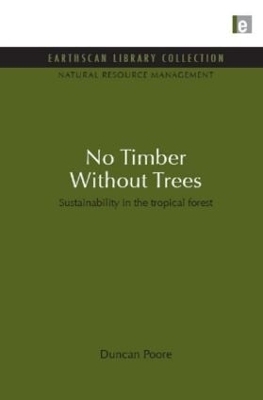
No Timber Without Trees
Earthscan Ltd (Verlag)
978-1-84971-024-4 (ISBN)
Much of the world's tropical timber is still supplied from natural forest, but under current systems of management the forests are rapidly becoming exhausted. Unless management practices change to become genuinely sustainable, neither the forests nor the essential contribution of the timber industry to many economies will survive.
Duncan Poore reviews the extent to which natural forests are already being sustainably managed for timber production, and looks at how these practices can be enlarged. He places management for timber in the wider context of tropical forest conservation and outlines a strategy for further action. Thoroughly researched and accessibly written, this book will be useful for everyone working or interested in the subject of tropical forests.
Foreword by Dato Dr B.C.Y. Freezailah
Originally published in 1989
Duncan Poore
Preface
Acknowledgements
I. The Sustainable Management of Natural Forest: the Issues Duncan Poore
Some Definitions
Natural Forest; Sustainable Timber Production; Sustainable Production per Unit Area and
Sustainable Supply; Management and its Intensity
The Context
The Trade and its Future Sources of Timber; the National Economic Context of Forest Management;
Sustainability and the Environmental Context; The Social Context
The Sustainable Development and Conservation of Tropical Forest Lands
What Does it Mean?; The Balance of Use; Conservation: the Moving Target; What is the Scope
of Tropical Forest Conservation?; What is the Starting-point?; The Elements of the Ideal; Economic and Social Considerations; Planning Considerations; International Dovetailing
Definition of Issues in the ITTO Study
Queensland, Australia: an Approach to Successful Sustainable Management
Duncan Poore
The Rain Forests
Distribution and Character; Policy; Area of the Forests and Status
Forest Management
Objectives; Timber Production; Silvicultural System; Calculation of the Annual Allowable Cut
Rainforest Logging
Volume of Timber; The Planning of Logging; Tree Marking; Environmental Guidelines; Effects
of Logging; Financial Considerations
Research
Conclusion
3. Africa Simon Rietbergen
Present State of Natural Forest Management and Exploitation
How much Forest is being Managed at Present?; What is Happening to the Tropical Moist Forest?;
Timber Exploitation and Processing
Forest Exploitation and Management: the Wider Context
Forest and Land-use Policy; Forest Legislation and Reservation; The Control of Logging; Socioeconomic and Financial Policy; Economic Circumstances Conditioning Forest Management; Information Needed for Forest Management
Conclusions
4. South America and the Caribbean
Timothy Synnott
Forest Land and its Control
Trinidad and Tobago; Brazil; Bolivia; Peru; Ecuador; Honduras
Forest Laws and Policy
Trinidad; Brazil; Bolivia; Peru; Ecuador; Yonduras
Forest Management and Silviculture
Trinidad; Brazil; Bolivia; Peru; Ecuador; Honduras
Research
Logging
Industries
Training
Appendix: Abbreviations
5. Asia P.F. Burgess
Forest Policy
The Forests and Forest Protection; Control of the Rate of Forest Utilization
The forests
Classification by Area; Selection, Demarcation and Protection; National Forest Inventory
Forest Operations and Management
Concession Agreements; Silvicultural Systems; Pre-felling Inventories; Marking for Fellings; Control
of Exploitation Damage and Quality of Residuals; Yarding: Methods and Slope Limits; Transport Systems, Road Design and Maintenance; Post-felling Inventories; Planting Voids and Enrichment Planting;
Security of Worked Coupes; Recruitment of the Regeneration Stock; Monitoring of the Developing Stand
Extent of Sustainable Management in the Region
Adequacy and Independence of Staff; Funding of Forestry Departments; Decentralization of Forest Departments: State Versus Federal Forests; Research and Training; Forestry Training
Prospects for Sustained-yield Management within the Region
Sustainable Supply; The Main Factors Hindering or Preventing Sustained-yield Management; Circumstances where Sustained-yield Management is Succeeding
6. Management of Natural Forest for Sustainable Timber Production: A Commentary John Palmer
Diagnosis with Examples of Problems
Demography; Social factors; Land Tenure; Cultural Factors; Technological Factors; Economic Factors;
Institutional Factors; Educational Factors; Research Information
Prescriptions for Improvement
Education and Recruitment; Policy Development; Institutional Development; Forestry Research; Gaps
in Information for Management of TMF; Critical Knowledge for Sustainable Management (Decision Chart)
Conclusion
7. Conclusions Duncan Poore
The Iindings of the study
Introduction; How much Forest is under Management for Sustainable Timber Production at an Operational scale?; Overall Picture
The Conditions for Sustainable Production
Long-term Security of Operation; Operational Control; A Suitable Financial Environment; Adequate Information; Conditions of Success
General Conclusions
8. Recommended Action Duncan Poore
The Elements of a Strategy for ITTO:
Recommended Actions
Promotion; Diagnosis Examples; Facilitation
9. Recent Developments Duncan Poore
ITTO: Substantial Progress
TFAP: Change of Gear
Actions by Producer Governments
Action by the Timber Trade
Consumer Campaigns
10. Postscript: an Uncertain Future
Duncan Poore
Additional Reading
Index
| Erscheint lt. Verlag | 1.10.2009 |
|---|---|
| Reihe/Serie | Natural Resource Management Set |
| Verlagsort | London |
| Sprache | englisch |
| Maße | 156 x 234 mm |
| Gewicht | 612 g |
| Themenwelt | Naturwissenschaften ► Biologie ► Ökologie / Naturschutz |
| Naturwissenschaften ► Geowissenschaften ► Geografie / Kartografie | |
| Sozialwissenschaften ► Soziologie ► Spezielle Soziologien | |
| ISBN-10 | 1-84971-024-4 / 1849710244 |
| ISBN-13 | 978-1-84971-024-4 / 9781849710244 |
| Zustand | Neuware |
| Haben Sie eine Frage zum Produkt? |
aus dem Bereich


